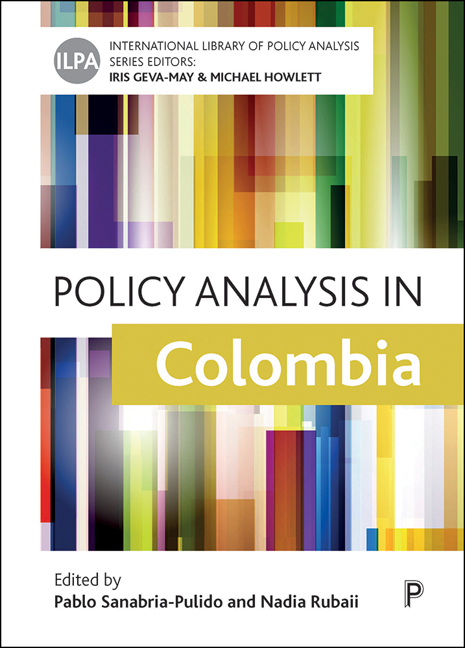Book contents
- Frontmatter
- Dedication
- Contents
- List of Figures and Tables
- List of Abbreviations
- Notes on Contributors
- Editors’ Introduction to the Series
- Policy Analysis in Colombia: An Introduction
- Part One Policy Analysis in Contemporary Colombia
- One The policy Analysis Movement in Colombia: The State of the Art
- Two Evolution of Policy Analysis as a Field of Study and Instruction in Colombia
- Three Policy Analysis, Bureaucratic Capacity and Public Administration Reforms in Colombia
- Part Two Policy Analysis within National and Subnational Governments
- Four Policy Analysis Inside Central Government in Colombia
- Five Policy Analysis and the Legislature in Colombia
- Six Policy Analysis in the Colombian Constitutional Court
- Seven Metropolitan Governance and Policy Analysis in Colombia
- Eight Policy Analysis for Decision Making in Colombian Local Governments
- Part Three Policy Analysis in Key Policy Domains
- Nine Policy Analysis in the Education Sector in Colombia
- Ten Policy Analysis in the Health Sector in Colombia
- Eleven Policy Analysis and Decision Making in the Military Forces: The Havana Experience
- Twelve Technocracy, Decision Making and Economic Policy in Colombia
- Thirteen Social Policy, Target Populations and Policy Analysis in Colombia
- Part Four Policy Analysis Beyond the State
- Fourteen Political Parties and Policy Analysis in Colombia
- Fifteen Policy Analysis and NGOs in Colombia
- Sixteen Media, Evidence and Policy Analysis in Colombia
- Conclusion: Building Capacity for Policy Analysis Amid Tensions and Challenges in Colombia
- Index
Ten - Policy Analysis in the Health Sector in Colombia
Published online by Cambridge University Press: 10 March 2021
- Frontmatter
- Dedication
- Contents
- List of Figures and Tables
- List of Abbreviations
- Notes on Contributors
- Editors’ Introduction to the Series
- Policy Analysis in Colombia: An Introduction
- Part One Policy Analysis in Contemporary Colombia
- One The policy Analysis Movement in Colombia: The State of the Art
- Two Evolution of Policy Analysis as a Field of Study and Instruction in Colombia
- Three Policy Analysis, Bureaucratic Capacity and Public Administration Reforms in Colombia
- Part Two Policy Analysis within National and Subnational Governments
- Four Policy Analysis Inside Central Government in Colombia
- Five Policy Analysis and the Legislature in Colombia
- Six Policy Analysis in the Colombian Constitutional Court
- Seven Metropolitan Governance and Policy Analysis in Colombia
- Eight Policy Analysis for Decision Making in Colombian Local Governments
- Part Three Policy Analysis in Key Policy Domains
- Nine Policy Analysis in the Education Sector in Colombia
- Ten Policy Analysis in the Health Sector in Colombia
- Eleven Policy Analysis and Decision Making in the Military Forces: The Havana Experience
- Twelve Technocracy, Decision Making and Economic Policy in Colombia
- Thirteen Social Policy, Target Populations and Policy Analysis in Colombia
- Part Four Policy Analysis Beyond the State
- Fourteen Political Parties and Policy Analysis in Colombia
- Fifteen Policy Analysis and NGOs in Colombia
- Sixteen Media, Evidence and Policy Analysis in Colombia
- Conclusion: Building Capacity for Policy Analysis Amid Tensions and Challenges in Colombia
- Index
Summary
Introduction
In 1993, Colombia overhauled its health system, transitioning from a national health system to a social health insurance system. This change represented important improvements in the way healthcare was provided as it expanded healthcare coverage, enhanced private sector participation, increased the flow of resources to the system and improved quality of healthcare in high-end urban hospitals (Giedion and Uribe, 2009; Vecino-Ortiz et al, 2018). Nonetheless, the reform came at a cost. It placed a focus on healthcare at the expense of essential public health functions (Jaramillo Pérez, 1999, p. 100; Rigoli and Dussault, 2003; Yepes, 2010; Vecino-Ortiz et al, 2018).
The reform also worked under the expectation that formal sector participation would increase within ten years, and that competition among private insurers would work as in any competitive market (Ruiz, 2018). Some of these assumptions proved to be incorrect and the accumulation of unaddressed market failures, persistently high numbers of informal workers, and a generous plan of benefits led to an imbalance between health system revenues and costs (Gaviria et al, 2006; Calderon-Mejia and Marinescu, 2012; Peñaloza et al, 2012; Vecino-Ortiz et al, 2018), placing the system at a high financial risk.
Both successes and challenges of the health system combined with increasing technical capacity in public sector institutions led the health sector to start approaching the policy process in a more formal fashion through policy analysis, to better inform policy options.
In this chapter, we discuss the development of policy analysis studies in the Colombian health sector since the health reform in 1993, and the heterogeneity of such development across different health sector institutions in the country. The chapter assesses how policy analysis in the health sector evolved over time, highlighting the divergent development in national-level and local-level institutions (Collins, 2005).
To develop the chapter, we conducted document reviews and six interviews with current and former high level officials from the Ministry of Health/Ministry of Social Protection (a merger between the Ministry of Health and Ministry of Labor between 2002 and 2011) and its related agencies.
- Type
- Chapter
- Information
- Policy Analysis in Colombia , pp. 169 - 186Publisher: Bristol University PressPrint publication year: 2020

